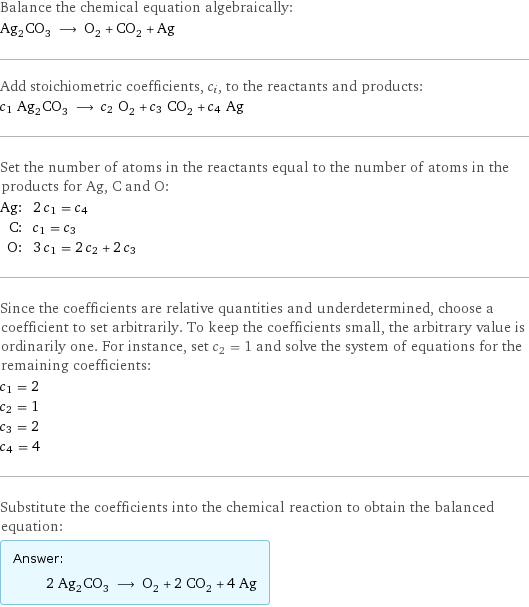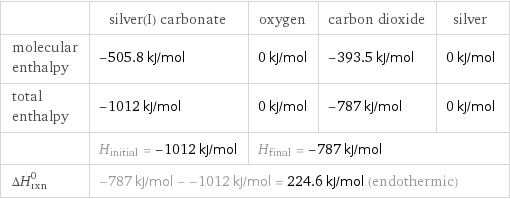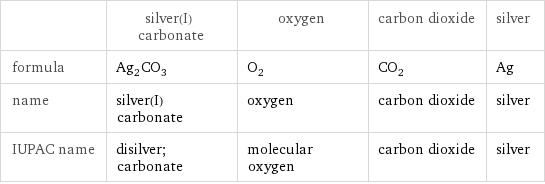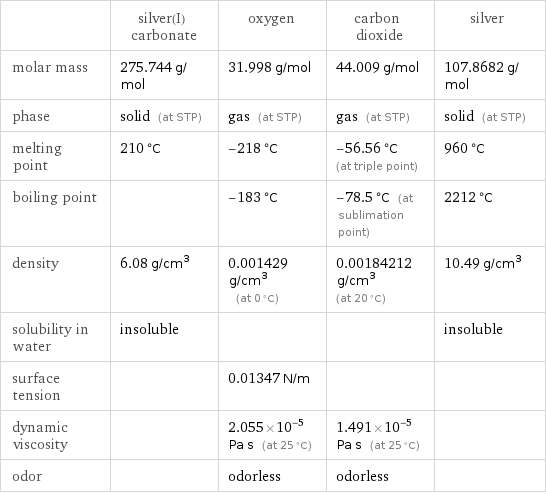Input interpretation

Ag_2CO_3 silver(I) carbonate ⟶ O_2 oxygen + CO_2 carbon dioxide + Ag silver
Balanced equation

Balance the chemical equation algebraically: Ag_2CO_3 ⟶ O_2 + CO_2 + Ag Add stoichiometric coefficients, c_i, to the reactants and products: c_1 Ag_2CO_3 ⟶ c_2 O_2 + c_3 CO_2 + c_4 Ag Set the number of atoms in the reactants equal to the number of atoms in the products for Ag, C and O: Ag: | 2 c_1 = c_4 C: | c_1 = c_3 O: | 3 c_1 = 2 c_2 + 2 c_3 Since the coefficients are relative quantities and underdetermined, choose a coefficient to set arbitrarily. To keep the coefficients small, the arbitrary value is ordinarily one. For instance, set c_2 = 1 and solve the system of equations for the remaining coefficients: c_1 = 2 c_2 = 1 c_3 = 2 c_4 = 4 Substitute the coefficients into the chemical reaction to obtain the balanced equation: Answer: | | 2 Ag_2CO_3 ⟶ O_2 + 2 CO_2 + 4 Ag
Structures

⟶ + +
Names

silver(I) carbonate ⟶ oxygen + carbon dioxide + silver
Reaction thermodynamics
Enthalpy

| silver(I) carbonate | oxygen | carbon dioxide | silver molecular enthalpy | -505.8 kJ/mol | 0 kJ/mol | -393.5 kJ/mol | 0 kJ/mol total enthalpy | -1012 kJ/mol | 0 kJ/mol | -787 kJ/mol | 0 kJ/mol | H_initial = -1012 kJ/mol | H_final = -787 kJ/mol | | ΔH_rxn^0 | -787 kJ/mol - -1012 kJ/mol = 224.6 kJ/mol (endothermic) | | |
Equilibrium constant
![Construct the equilibrium constant, K, expression for: Ag_2CO_3 ⟶ O_2 + CO_2 + Ag Plan: • Balance the chemical equation. • Determine the stoichiometric numbers. • Assemble the activity expression for each chemical species. • Use the activity expressions to build the equilibrium constant expression. Write the balanced chemical equation: 2 Ag_2CO_3 ⟶ O_2 + 2 CO_2 + 4 Ag Assign stoichiometric numbers, ν_i, using the stoichiometric coefficients, c_i, from the balanced chemical equation in the following manner: ν_i = -c_i for reactants and ν_i = c_i for products: chemical species | c_i | ν_i Ag_2CO_3 | 2 | -2 O_2 | 1 | 1 CO_2 | 2 | 2 Ag | 4 | 4 Assemble the activity expressions accounting for the state of matter and ν_i: chemical species | c_i | ν_i | activity expression Ag_2CO_3 | 2 | -2 | ([Ag2CO3])^(-2) O_2 | 1 | 1 | [O2] CO_2 | 2 | 2 | ([CO2])^2 Ag | 4 | 4 | ([Ag])^4 The equilibrium constant symbol in the concentration basis is: K_c Mulitply the activity expressions to arrive at the K_c expression: Answer: | | K_c = ([Ag2CO3])^(-2) [O2] ([CO2])^2 ([Ag])^4 = ([O2] ([CO2])^2 ([Ag])^4)/([Ag2CO3])^2](../image_source/4a8c4f04934d2e635ca6f54f835fa7c3.png)
Construct the equilibrium constant, K, expression for: Ag_2CO_3 ⟶ O_2 + CO_2 + Ag Plan: • Balance the chemical equation. • Determine the stoichiometric numbers. • Assemble the activity expression for each chemical species. • Use the activity expressions to build the equilibrium constant expression. Write the balanced chemical equation: 2 Ag_2CO_3 ⟶ O_2 + 2 CO_2 + 4 Ag Assign stoichiometric numbers, ν_i, using the stoichiometric coefficients, c_i, from the balanced chemical equation in the following manner: ν_i = -c_i for reactants and ν_i = c_i for products: chemical species | c_i | ν_i Ag_2CO_3 | 2 | -2 O_2 | 1 | 1 CO_2 | 2 | 2 Ag | 4 | 4 Assemble the activity expressions accounting for the state of matter and ν_i: chemical species | c_i | ν_i | activity expression Ag_2CO_3 | 2 | -2 | ([Ag2CO3])^(-2) O_2 | 1 | 1 | [O2] CO_2 | 2 | 2 | ([CO2])^2 Ag | 4 | 4 | ([Ag])^4 The equilibrium constant symbol in the concentration basis is: K_c Mulitply the activity expressions to arrive at the K_c expression: Answer: | | K_c = ([Ag2CO3])^(-2) [O2] ([CO2])^2 ([Ag])^4 = ([O2] ([CO2])^2 ([Ag])^4)/([Ag2CO3])^2
Rate of reaction
![Construct the rate of reaction expression for: Ag_2CO_3 ⟶ O_2 + CO_2 + Ag Plan: • Balance the chemical equation. • Determine the stoichiometric numbers. • Assemble the rate term for each chemical species. • Write the rate of reaction expression. Write the balanced chemical equation: 2 Ag_2CO_3 ⟶ O_2 + 2 CO_2 + 4 Ag Assign stoichiometric numbers, ν_i, using the stoichiometric coefficients, c_i, from the balanced chemical equation in the following manner: ν_i = -c_i for reactants and ν_i = c_i for products: chemical species | c_i | ν_i Ag_2CO_3 | 2 | -2 O_2 | 1 | 1 CO_2 | 2 | 2 Ag | 4 | 4 The rate term for each chemical species, B_i, is 1/ν_i(Δ[B_i])/(Δt) where [B_i] is the amount concentration and t is time: chemical species | c_i | ν_i | rate term Ag_2CO_3 | 2 | -2 | -1/2 (Δ[Ag2CO3])/(Δt) O_2 | 1 | 1 | (Δ[O2])/(Δt) CO_2 | 2 | 2 | 1/2 (Δ[CO2])/(Δt) Ag | 4 | 4 | 1/4 (Δ[Ag])/(Δt) (for infinitesimal rate of change, replace Δ with d) Set the rate terms equal to each other to arrive at the rate expression: Answer: | | rate = -1/2 (Δ[Ag2CO3])/(Δt) = (Δ[O2])/(Δt) = 1/2 (Δ[CO2])/(Δt) = 1/4 (Δ[Ag])/(Δt) (assuming constant volume and no accumulation of intermediates or side products)](../image_source/55e6ed1e41f98300cc30fcda4897ea93.png)
Construct the rate of reaction expression for: Ag_2CO_3 ⟶ O_2 + CO_2 + Ag Plan: • Balance the chemical equation. • Determine the stoichiometric numbers. • Assemble the rate term for each chemical species. • Write the rate of reaction expression. Write the balanced chemical equation: 2 Ag_2CO_3 ⟶ O_2 + 2 CO_2 + 4 Ag Assign stoichiometric numbers, ν_i, using the stoichiometric coefficients, c_i, from the balanced chemical equation in the following manner: ν_i = -c_i for reactants and ν_i = c_i for products: chemical species | c_i | ν_i Ag_2CO_3 | 2 | -2 O_2 | 1 | 1 CO_2 | 2 | 2 Ag | 4 | 4 The rate term for each chemical species, B_i, is 1/ν_i(Δ[B_i])/(Δt) where [B_i] is the amount concentration and t is time: chemical species | c_i | ν_i | rate term Ag_2CO_3 | 2 | -2 | -1/2 (Δ[Ag2CO3])/(Δt) O_2 | 1 | 1 | (Δ[O2])/(Δt) CO_2 | 2 | 2 | 1/2 (Δ[CO2])/(Δt) Ag | 4 | 4 | 1/4 (Δ[Ag])/(Δt) (for infinitesimal rate of change, replace Δ with d) Set the rate terms equal to each other to arrive at the rate expression: Answer: | | rate = -1/2 (Δ[Ag2CO3])/(Δt) = (Δ[O2])/(Δt) = 1/2 (Δ[CO2])/(Δt) = 1/4 (Δ[Ag])/(Δt) (assuming constant volume and no accumulation of intermediates or side products)
Chemical names and formulas

| silver(I) carbonate | oxygen | carbon dioxide | silver formula | Ag_2CO_3 | O_2 | CO_2 | Ag name | silver(I) carbonate | oxygen | carbon dioxide | silver IUPAC name | disilver; carbonate | molecular oxygen | carbon dioxide | silver
Substance properties

| silver(I) carbonate | oxygen | carbon dioxide | silver molar mass | 275.744 g/mol | 31.998 g/mol | 44.009 g/mol | 107.8682 g/mol phase | solid (at STP) | gas (at STP) | gas (at STP) | solid (at STP) melting point | 210 °C | -218 °C | -56.56 °C (at triple point) | 960 °C boiling point | | -183 °C | -78.5 °C (at sublimation point) | 2212 °C density | 6.08 g/cm^3 | 0.001429 g/cm^3 (at 0 °C) | 0.00184212 g/cm^3 (at 20 °C) | 10.49 g/cm^3 solubility in water | insoluble | | | insoluble surface tension | | 0.01347 N/m | | dynamic viscosity | | 2.055×10^-5 Pa s (at 25 °C) | 1.491×10^-5 Pa s (at 25 °C) | odor | | odorless | odorless |
Units
